
How Developing a Strong Style and Laser-Like Focus is One of the Most Important Things You Can Do for Your Fine Art Career
A number of years ago, I was approached by an artist who was seeking gallery representation in Scottsdale. She had been into the gallery during an opening and, after striking up a conversation, had asked if she might stop back by the gallery and present her portfolio to me when I had more time. I had agreed and she was now back in the gallery on a quiet weekday afternoon with portfolio in hand.
The moment I saw the portfolio I knew I was in trouble. I am not exaggerating to say that this portfolio was at least two inches thick and must have weighed a good eight or nine pounds. After a brief conversation and reintroduction, she handed me the portfolio and said, “This is really only a small sampling of my work – I’ve been painting for over forty years and I have hundreds more images.”
I opened the portfolio and began randomly paging through with the artist looking expectantly on.
There was simply too much work in the portfolio, and I felt as if I were taking a survey of the entirety of art history. The work literally encompassed every style from cave painting (granted, an abstract take on it) to the Renaissance, the Impressionists, and all of the modern movements since – expressionism, minimalism, and pop, to name a few.
“Your work is quite diverse,” I said.
The artist took it as far more of a compliment than I intended. “I’ve always felt,” she said, “that it’s important not to get myself pigeonholed into one particular style or theme . . . I like to keep my work fresh.”
I don’t remember the rest of our conversation – although I’m sure I politely waved her off with a stock “we don’t have any room right now,” or “we’re not the right fit.” Looking back, I wish I would have taken the time to give her feedback on her presentation and body of work, as she surely went on to have a very difficult time persuading a gallery to carry her work using that all-encompassing approach.
While this is an extreme example, I encounter variations of this approach quite frequently. Now that I have been in the business longer and have more experience working with artists, I always try to have a conversation about the importance of consistency (not to mention the importance of creating a concise portfolio).
So why is it important to develop a consistent body of work?
. . . the decision I am ultimately making is whether I am willing to invest in the artist and their work . . .
Step into my shoes for a moment and view your art through the eyes of a gallery owner. You will quickly see that as I consider an artist for representation, the decision I am ultimately making is whether I am willing to invest in the artist and their work.
I am going to devote expensive wall or pedestal space to displaying the art. I am going to have staff spending time and resources promoting and selling the work. I am going to spend advertising dollars informing potential clients about the work. In order to make this kind of commitment, I have to feel confident that I can see a return on the investment.
This is not to say that I am not willing to stretch and take risks with unproven artists, but I am far less likely to make such an investment if I see inconsistency in the work. My concern is that I will make the investment and begin to build a following for the artist’s work, only to have the artist make a sudden and drastic change in their style, forcing me to start over again. It can sometimes take years to build a following for an artist, and during that time a steady stream of consistent work is key.
Of course, there are many other considerations – quality, creativity, and confidence – but consistency is actually one of the first indicators I look for as it often speaks to the other factors as well.
In fact, when asked what an artist should do to increase their odds of finding gallery representation and building long-term commercial success, consistency would be the very first factor to which I would point. That’s right. Even above quality and creativity, I feel that consistency is the key to long-term success.
So what do I mean by “consistency”? Many artists hear the word and feel a cold sweat break on their brow. Most artists can understand the importance of consistency almost instinctually, but when it comes to actually creating a body of consistent work, they’re not sure where to begin. Does this mean they should only have one style and one subject? Does it mean they don’t have any latitude to experiment and evolve? Does consistency become a straitjacket to creativity?
To answer these questions we need only delineate our goal. While my ultimate goal is to sell an artist’s work and create a base of collectors who will sustain the artist over the long term, the immediate goal in terms of consistency is much simpler: when someone walks into my gallery, I want them to see a number of your pieces and have them be able to instantly recognize all of the work as having been created by one artist. I want the artist (you!) to give them a strong thread running through the work that ties it all together. From the first piece they encounter to the last, I want them to look at each and see its relation to the others.
Furthermore, when that same client walks into the gallery a year from now, I want them to see and recognize the new work in the gallery at that time as yours. In the marketing world they call this “branding,” and that is exactly what we want to accomplish with your work.
Seeing consistency this way, you will realize that you do have some latitude to vary your work. You can paint landscapes and still lifes as long as the style or presentation ties the work together. You can sculpt figures and animals as long as the visual language is consistent across the work. You can even vary the media you employ to create the work if the subject matter and theme are unified.
A few illustrations from artists in my gallery will help to illustrate what I mean:
Guilloume. Even though this artist works in oil and bronze, his figurative subject matter and his consistent style translates across the mediums. There is no doubt in a viewer’s mind that this work was created by a single artist with a clear vision of his work.
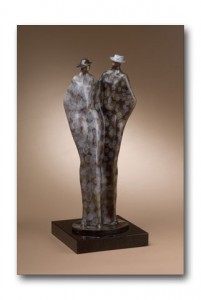
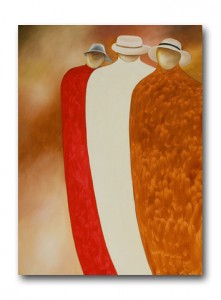
Lorri Acott. Lorri produces in both bronze and clay mediums and sculpts both animals and figures, but her style is consistent and clear. Through the use of elongated limbs and a “cracking” in her forms, both humans and horses are easily identified as being Lorri’s work.
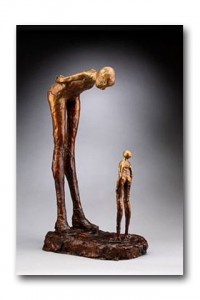
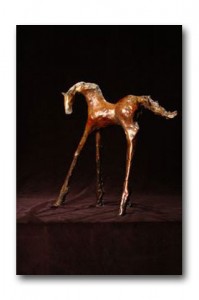
John Horejs (full disclosure, this artist is my father). Though creating desert and mountain landscapes, florals, and still-life work, Horejs’ style and presentation tie his work into a cohesive body.
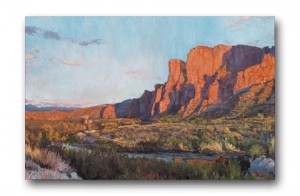
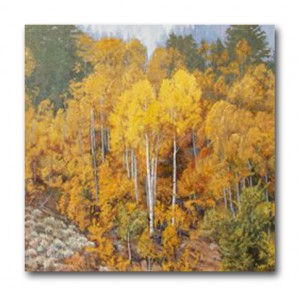
Dave Newman. Newman’s nostalgic Americana inspired style is both unique and consistent.Though Newman relies on random found objects to create his imagery, he has a very clear vision of how he will give these objects context and how the objects relate to one another. Again, presentation becomes an important part of the equation in creating consistency in Dave’s work.
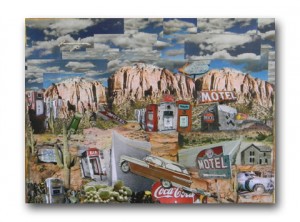
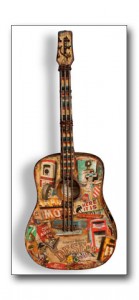
Jeanie Thorn. It is easy to identify Jeanie’s work by the materials she consistently employs. While she varies the size and shape of her sculptures, there is an obvious unification amongst her work that allows visitors to the gallery to locate her work with ease, even when it is scattered across multiple walls.
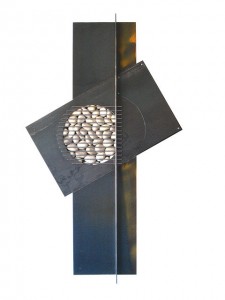
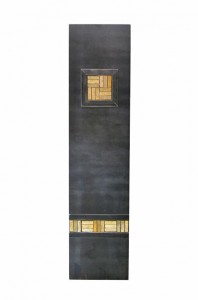
“But Jason,” you object, “I’m afraid I am going to get pigeonholed into my current style or subject matter and frankly, I just get bored quickly.” I understand these concerns. Here are some considerations that will allow you to live with (and embrace) consistency:
- Edit. The great allure of being an artist is that you get to try new things and you are your own master. I’m not suggesting that this has to end, that you are stuck for the rest of your life creating the same art over and over again. What I am suggesting is that you make a conscious decision that the work you are preparing to present to the public or to galleries must be consistent. You can do the abstract work if you are primarily a landscape painter, but don’t include it in your public portfolio. Edit your work down to only the work that is congruent.
- Give yourself parameters. Allow yourself one experiment out of every 20 pieces – 19 are going to be the consistent, the twentieth can be whatever you feel like doing. This twentieth piece might end up hanging in your private collection or might become a gift to a friend or family member.
- Evolve. “Look at Picasso,” you say, “he didn’t just stick with one thing throughout his life.” I will agree with you, but if you look at the arc of the lifetime of work Picasso created, you will see an evolution over years and decades. What I want you to avoid is the bi-monthly reinvention that many artists experience on a regular basis (you may be going through this now).
Now here’s the secret about passion: passion isn’t that feeling you get when you first try something. True passion comes after you’ve sacrificed and devoted yourself, after you have been true to your commitment
- Choose. Sometimes a lack of consistency comes not out of a love of variety but instead out of a fear of commitment. You might have three or five (or twenty!) different styles you have dabbled in and you’re just not sure which one is the right fit – which one will engender success and sales. I am often asked what style of art sells the best. My answer is simple: the style which any individual artist is most passionate about. Art taps emotion and you are going to be far better at selling if you can make a primal connection with your viewer. You are going to be far better at making this kind of connection if you are creating work that you are passionate about. Now here’s the secret about passion: passion isn’t that feeling you get when you first try something. True passion comes after you’ve sacrificed and devoted yourself, after you have been true to your commitment. There are no two ways about this and you are eventually going to have to make a decision when it comes to your direction – so why not make it now?
- Cheat. If you have work that is close but not quite consistent, you can fudge a bit by simply using a consistent presentation. You would be amazed at the variety of work that can show together simply because it’s in the exact same frame or has an identical base. There are limits to how far you can push this cheat, but in a pinch it can maintain your portfolio’s consistency.
I met another artist several years ago who had made a commitment to consistency. She decided to focus on one subject for a year. Instead of becoming bored with the subject, she reported that the more time she spent with it, the more she began to see that there is an infinity of variety in the nuances of any subject.
If you have a problem with consistency, I encourage you to make a similar commitment. I promise you that this commitment will have a revolutionary effect on your work and your success as an artist.
What Do You Think?
Do you feel consistency is important? What have you done to maintain consistency in your work? What are your greatest challenges as you seek consistency in your work?
I think the consistency of artwork is important for galleries and often helps submissions to be accepted in online juried shows. I think Jason’s thoughts about my website and all his public shared messages are important for me to follow.
Jason I could not agree with you more about consistency. The art gallery is usually not a good place to “experiment” a lot with your art. A gallery accepts an artist for the initial works that they view, and it can be disappointing to a gallery when the artist keeps presenting completely different works that don’t fit the vision and aesthetic of the gallery going forward.
I appreciate the idea of consistency especially for a Gallery. I may never achieve it other than in expressing a bodacious & loose application of paint and marks or the liberty taken with a subject matter . Non-objective is enticing but not always. I cannot imagine giving up the ability to use all faculties or giving up painting statements of emotions or global events.
Website in process of renewal
See Instagram carolinem.fremont
I’ve made the commitment to be more consistent in my work and am finding it not only enlightening as to who I am and what I want to say as an artist but the focus and clearer direction is freeing up my mind. I’ve always had so many ideas My head would spin with what to focus on. But now I say. Someday I might get to that idea. Let me just jot it down in a sketch. But back to the direction of this body of work that I am really about! Thanks Jason.
Hmmm. As a result of this article, I’m going to haul out my recent work and take a good look at what *might* be the consistancies. I’ve been kinda stuck this past year, pulled in at least two directions about my work. Thinking about being consistant might be the dam breaker.
The intro about seeing that large portfolio of diverse work resonates. I used to read science fiction; I would walk into a store and would have a choice of 4 or 6 new books. I would spend 15 minutes or so browsing and decide on one of them. Now, I walk into a store and am faced with one or two walls of science fiction books…and I turn around and walk out or head into the history section.
A revolution is needed. Imagine a new kind of gallery. This gallery promotes the artist, rather than the product. When Artist X has a show coming up, the gallery advertises with teasers like, “Wait till you see what Artist X is doing now! His signature intensity and perfectionism are all over his latest works in a whole new way!” Our imaginary gallery promotes an artist the way an agent promotes an actor who can play a variety of roles. “Be dazzled by his versatility and ingenuity! Buy now, before the works from this series are all gone!!!” We all know that local markets can easily become saturated with an artist’s work, so an artist who evolves is ideal from a marketing standpoint.
Yes, that would be some gallery!! Artists go to galleries thinking first and foremost about art, whereas galleries think MARKETABILITY. I’ve seen this over and over, whether in my own experience, or seeing it in other instances such as video programs where gallery owners visit artists’ studios. The first thing out of one gallery owner’s mouth, pointing at various paintings during one such visit, was “I can sell that!…I can sell that, too!” Not really anything of intelligence about the work, but only about the sale of the work. Of course that is the purpose of the gallery, so that’s what they do, BUT artists and gallery owners are just coming from two different places and because of that, of course they will often be at cross purposes. Not many artists have the ability to maintain a distinctive visual ‘brand’ while expanding their creativity. I see WAY too many ‘established’ artists in good, higher-end galleries that have been doing the same-old work in the same-old style, even using the exact same-old color palette for decades-!!! I left the gallery I’d been with for 8 years in part because if I had to do one more variation of the first painting that I sold there, at the constant urging of the dealer, I was going to HURL. I was under the mistaken impression that it was part of the gallerist’s skill set to gently support the artist’s creative journey, not set limits on it, and that would include talking to prospective collectors about the artist’s evolution and respecting collectors enough to assume they could follow the creative process. But that is just my pipe dreaming and I know better now. It doesn’t matter if work is good, it doesn’t matter what the artist is going through or their journey, it just matters to galleries if the work is MARKETABLE. If it also turns out to be good, that’s just an incidental bonus, not a requirement.
I so agree with you.
I follow artist because of their style of work. Kevin Red Star is a good example. I enjoy his work and finding new nuances with each look. His style speaks to me. I can walk into any gallery and spot his work and if a new piece arrives I know it’s his. It’s the same with my art. People see it and they know I’m the artist. After years of experimenting with different mediums and styles I’m finally getting recognized for my distinct style of work. You can look at my acrylic paintings and never know I produced them because the subjects and style are everywhere. My equine watercolors- are mine. No one else paints like I do and I’m finally happy and satisfied with what I produce. Consistency is everything
I agree with you. I also Think Jason knows what he’s talking about and I needed that nudge to be more consistitant with my work.
As an aspiring professional artist looking for a gallery, I find Jason’s advice very consistent with other instruction I have received about creating a “placement” of my work in the art fan/collector community. Literally everything that is widely sold or followed online, in my opinion, has to do with style branding as a trust/value builder for the art investor/purchaser. After over 400 oil paintings since I began as an amateur, there is now more recongnizable consistency than ever in my recent paintings. That consistency, in my opinion, has developed naturally with experience and understanding the trends in today’s oil paintings.
An artist’s “style” is one of the most contentious topics there is. Many artists believe that they should just “fall into it”. Other artists feel that they should consciously think about and develop it. I’m in that latter group. An artist’s style doesn’t have to be forever, but like Picasso, it has has to be a container that will hold a lot of work and last for a decade or so. So it needs to be large. And it has to be made up of an artist’s strengths, their passions, and has to help conceal their weaknesses. This is why I believe it needs to be thought out rather than merely happened on. It takes experimentation and planning. But once found, it is also a lifesaver! Everything makes sense once you have it – to you, and to your dealers, and to your public..
I have been told that people can always identify my work, but I’m not sure that’s true since I paint figures, abstracts and landscapes. I’m looking for a way to keep doing that but also with continuity. What can tie them together? Using the same palette? The same application of paint? I like what Michelle Gaughy says, that your style has to be a container that will hold a lot of work (perhaps of different subjects and even styles). Can an artist do an abstract that is recognizable as hers in a painting of a figure? There must be a way.
This is great advice! I have found myself wandering off my beaten path lately, including a portrait of a Native American, two horse paintings, etc. My work is normally beautiful skies, landscapes, some flowers, etc. I love color and my work has been called “happy”. I really need to concentrate on developing a consisent body of work. I am taking your advice and will be working on this going forward. Always love your articles. Thank you for continuing to help artists across the country.
This is advice I have heard most of my artistic career: develop a style so that when people look at it they can recognize it as yours.
I love to experiment and try new things, however my portfolio concentrates on my realistic work and should I decide to reach out to a gallery I will use this portfolio as it is more consistent. I certainly understand why this works better for galleries.
Thanks for another great post, Jason.
Of course Jason’s right…. In a gallery in particular you don’t want a wall with a series of paintings that look like they’re from twenty different people. Just the basics of display needs to be consistent. I’ll admit, I’m not a constant artist. What I’ve tried to be consistent with though is to do some series. A “series” of water with similar framing. A year or two ago I did an On the Road series with some views out of the windows of a car. Currently I seem to be on a southwest theme, even though I live in Washington where you can’t escape the greenery. I think one of the hardest things for Artist can be the framing. Everyone seems to go with simple black frames in many of the shows. My work doesn’t always lend itself to black frames, whether they are plein air frames or more modern. We all know that many times the client will change the frame to fit their decor but I ignore it and use the frame I think looks best with the work,,,
I’m at the beginning of my artistic voice creation. I love reading Jason’s blog because of all the nuances he mentions. I’ve heard consistency is key, but the reality of “sticking with one subject for a year” or his other suggestions are what is really, REALLY, helpful. Thank you, Jason, for what you do for us!
I totally agree with you, Jason.
I am a Graphic Designer/Illustrator by profession, but have been drawing and painting since my childhood and have always stuck with this. (I originally wanted to become an artist, but received the “starving artist” lecture from my parents, and decided to head in a different direction.) I did keep a portfolio of some of my drawings and paintings since college, however. About 25 years ago, I showed my portfolio to a couple of professional artists I’d met and become acquainted with. At the time, my sample pieces encompassed landscapes, still-lifes, portraits of people and animals, nautical environments, lighthouses, sailing ships and even some science fiction/fantasy/horror artwork — with my media varying from acrylic to pen-and-ink to watercolor to graphite renderings to digital artwork. Both the artists gave me the same evaluation. They said I could never get into a gallery because my art was too diverse. One even went so far as to say that I was not an “artist” at all, but merely an “illustrator.” They went on to explain a little about what galleries look for, and pretty much mimicked what you just said about CONSISTENCY. I went away feeling a bit downtrodden.
Two-and-a-half decades later, as I turn 65 and am seriously thinking about retiring from graphic design, I am also determined to segue into an art career. At this point, however, the importance of what they (and you) have said has become apparent to me, and I am determined to now begin producing a body of work that is consistent, in hopes of eventually getting gallery representation.
I have a consistent portfolio, but early in my career it was labeled “depressing” by several people I know who are collectors and expressed interest in my work. I had considered changing my style (to please these people) but quickly dismissed it because it wouldn’t have been genuine. Regrettably, I allowed this experience to negatively affect me. Convinced that my work would be a “hard sell,” I put my gallery search on hold-for years.